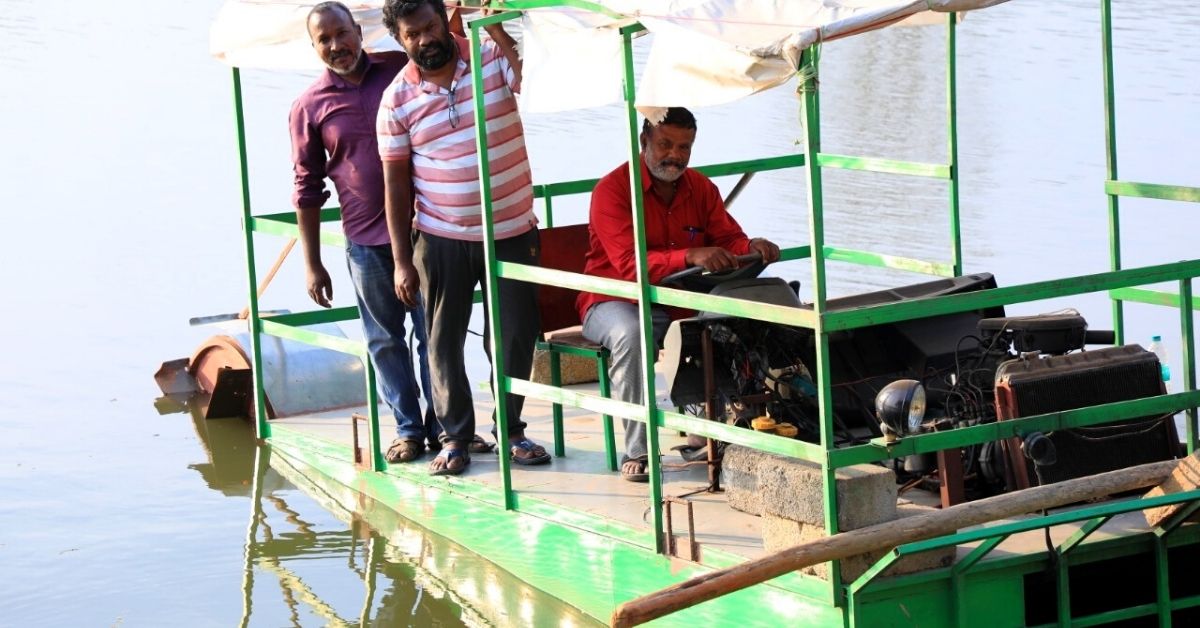The unwanted and visually unaesthetic view of water hyacinth carpeting water bodies is a common sight. Mainly caused due to pollution in water bodies, water hyacinth grows rapidly and invades biodiversity. It impacts the population of living beings in the water, because it grows on the surface and blocks sunlight, thus reducing oxygen levels.
Water hyacinth also affects human lives, which depend on these water bodies for livelihood. Such was the case of 100-odd fishermen from Bengaluru, whose sole means of earning a living is the Hebbal Lake. The 150-acre lake, which is one of the oldest water bodies in the city, had become a breeding ground for water hyacinth.
The thick vegetation restrained fishermen from entering the lake, moving around in their boats, and catching fish. Farmers of Matsaganga Meenugaarara Sahakara Sangha, a cooperative society, had leased the water body from the state forest department to claim fishing rights, but found themselves in a fix. “We paid Rs 6 lakh for fish seeds. But the effort and money turned futile due to the invasive weed,” says Arokiyaswamy Shamanna, one of the directors of the community cooperative.
Despite taking various efforts to get rid of the water hyacinth, the problem persisted. Seeking inspiration from road levellers used in construction, he designed and built a dozer machine from scrap, which could help reduce the weed management cost to one per cent of its original.
When repeated efforts brought no respite

“We took credit from society and spent Rs 15 lakh in 2020, trying to manage the weeds. We also received funds of Rs 4 lakh from a five-star hotel. But the vegetation kept growing. The community contributed to pay Rs 20,000 for 20 labourers who worked to remove the weeds. Eventually, the costs became unaffordable,” he says.
Arokiyaswamy adds that in October 2020, he came across a road leveller and thought about building a similar machine to root out water hyacinth. “A low-cost machine to do this was unknown, and the commercially available one was priced at about Rs 30 lakh. So we tried to create a huge bucket from scrap. The bucket had a holding capacity of 1.5 tonnes and was attached to the excavator, which pulled out the weed. The labourers would enter the water and push the water hyacinth towards the borders. But it became a tedious task, and we ended up spending Rs 1.35 lakh in a month,” he tells The Better India.
With no respite from the problem, Arokiyaswamy began designing a machine himself. “We collected funds and bought an old ambassador car engine and a drivetrain from a scrapped Sumo SUV. We also procured wooden planks, empty barrels and a couple of fans to float the dozer machine on the water. Blades were attached to the propeller to move the vehicle,” he adds.
After taking help from a local automobile mechanic, the dozer machine was constructed in two months at Rs 2 lakh.
An inspiring innovation
Govind Raju, his assistant, says, “Arokiyaswamy could not sleep during the time we were working on the machine. The plans and ideas kept flowing, he used to say.”
Govind says that with the machine, the fishermen only had to spend Rs 1,500 on fuel, and could save thousands of rupees a week. “We built it at a much lower cost. We have been using it since January 2021, and it can clear 3-4 acres of water hyacinth daily. The issue of mosquitos has also reduced, and catching fish has become an easy task,” he adds.
The fishermen community has received an overwhelming response for their efforts, with many visitors now curious to learn more about their innovation. “Officials from the fisheries department visited and requested that we put the dozer machine on display for students and farmers. The students from Reva University also visited the area to learn about the principles and techniques used in making the machine,” Govind says.
Arokiyaswamy says that he is glad that his efforts paid off and that he was able to save costs. “We are saving a lot of money and time. It is satisfying to know that a machine made from scrap has become immensely useful and also a source of inspiration for others to learn,” he adds.
Edited by Divya Sethu
If you found our stories insightful, informative, or even just enjoyable, we invite you to consider making a voluntary payment to support the work we do at The Better India. Your contribution helps us continue producing quality content that educates, inspires, and drives positive change.
Choose one of the payment options below for your contribution-
By paying for the stories you value, you directly contribute to sustaining our efforts focused on making a difference in the world. Together, let's ensure that impactful stories continue to be told and shared, enriching lives and communities alike.
Thank you for your support. Here are some frequently asked questions you might find helpful to know why you are contributing?

